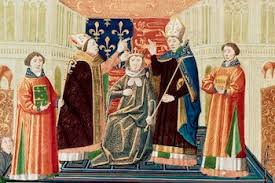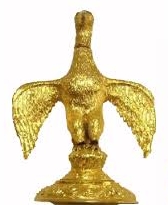
Henry IV, also known as Henry of Bolingbroke was the son of John of Gaunt who was the fourth son of Edward III and the third son to survive to adulthood. His mother was Blanche of Lancaster was a descendant of Henry III.
Henry joined in 1386 a group of opposition leaders to Richard II – the lords appellants – who outlawed Richard’s closest associates and forced the king to accept their counsel. The following year, Henry’s father died. Richard then seized the family estates, depriving Henry of his inheritance and this prompted Henry to invade England. He met little opposition, as many were horrified by the king’s actions. Richard surrendered in August 1399. It was claimed that Richard had abdicated of his own free will. Henry of Bolingbroke thus usurped the throne of England.
Henry’s accession is dated the 30 September 1399. Henry IV was crowned at Westminster Abbey on Monday 13 October 1399. Thomas Arundel, Archbishop of Canterbury performed the ceremony. Henry added a few changes to the coronation. He added the dubbing of 46 knights 2 days before the coronation who had joined him at the Tower of London. They spent the night maintaining a vigil and were ritually bathed, similarly Henry undertook such. The following day they were knighted during morning Sunday mass. Later that day they accompanied Henry in procession to Westminster dressed in matching long green robes and hats trimmed with white fur and decorated with cords and tassels of white silk.
 On the afternoon of Sunday 12 Oct the procession from the Tower of London to Westminster took place. Henry rode bare-headed on a white horse wearing a short doublet of gold cloth, a blue garter on his left leg and the badge of the King of France around his neck. Henry was accompanied by over 2000 lords, ladies, knights, clerks and household servants, all wearing new robes together with three times as many horses. The mayor and peoples of London were arranged in fur-trimmed scarlet uniforms and displayed their company badges. Thomas Erpingham carried the sword and Tomas Percy carried the Stewart’s baton. They wore red velvet or silk. The streets were highly decorated and wine flowed through conduits for drinking.
On the afternoon of Sunday 12 Oct the procession from the Tower of London to Westminster took place. Henry rode bare-headed on a white horse wearing a short doublet of gold cloth, a blue garter on his left leg and the badge of the King of France around his neck. Henry was accompanied by over 2000 lords, ladies, knights, clerks and household servants, all wearing new robes together with three times as many horses. The mayor and peoples of London were arranged in fur-trimmed scarlet uniforms and displayed their company badges. Thomas Erpingham carried the sword and Tomas Percy carried the Stewart’s baton. They wore red velvet or silk. The streets were highly decorated and wine flowed through conduits for drinking.
After Henry’s vigil and bath, he began his coronation day by taking confession and hearing three masses. Just before 0900 hrs the monks of Westminster and other clergy went from the Abbey to the palace and waited outside the royal chamber. Henry wearing sandals was then purified with holy oil and incense by the Archbishop of Canterbury and York before being taken to the Abbey. A canopy to which was attached 4 gold bells and made of blue silk was held above Henry by silver poles by four people from Cinque Ports. The Bishop of London carried the sacraments and sang mass. On one side of Henry was young 13 year old Prince Henry carrying the Curtana or coronation sword and on the other side of Henry was the Earl of Northumberland carrying a sword known as the Lancaster sword. John Beaufort, Earl of Somerset and Earl of Warwick carried a sword wrapped in red and bound with golden straps symbolising twofold mercy. Thus Four swords instead of three were carried around the King.
The ceremony was generally based on established custom. On entering the Abbey, the procession moved towards the elevated stage between the transepts covered with crimson cloth. On top of the stage was the coronation throne draped on gold cloth. Henry stepped up on the platform and sat on the throne. The Archbishop who walked up with Henry turned around towards the congregation asking if they wanted Henry as King to which they replied loudly: “Yes”. The Archbishop then turned back to Henry and read the 4 articles of the coronation oath to which Henry swore to uphold. At the coronation he made a speech in English. Before this, the official language of the court was French, ever since William I conquered England. Both left the stage and approached the altar. The paving stones were covered again in gold cloth. Henry upper body clothing was then removed and his hands, chest, shoulders, upper back, arms and head were anointed. The congregation sang Veni Creator Spiritus.
 The Ampulla, of solid gold and in the form of an eagle, which contains the oil with which the Archbishop of Canterbury anoints the Sovereign is still in use. It was last used for the coronation of Queen Elizabeth II. It is believed that this same Ampulla was also used for the Coronation of Henry IV in 1399, although design modifications have probably occurred over the centuries.
The Ampulla, of solid gold and in the form of an eagle, which contains the oil with which the Archbishop of Canterbury anoints the Sovereign is still in use. It was last used for the coronation of Queen Elizabeth II. It is believed that this same Ampulla was also used for the Coronation of Henry IV in 1399, although design modifications have probably occurred over the centuries.
After the ceremony the feasting began and part way through included the tradition of interruption by the Kings Champion (Sir Thomas Dymock). He entered through the great north door on horseback in full armoury with other knights carrying Henrys sword and shield.
Henry first married Mary de Bohun, daughter of Humphrey de Bohun, 7th Earl of Hereford, and Joan FitzAlan. She was only about 12 years old. It is believed the marriage took place on 5 February 1381, at Mary’s family home of Rochford Hall, Essex or possibly at Arundel Castle. Her coronation details are unknown.
On 7 February 1403 Henry married his second wife, Joanna of Navarre, the daughter of Charles d’Évreux, King of Navarre, at Winchester. On the 26th of the same month, she held her formal entry to London, where she was crowned queen of England by Thomas Arundel, Archbishop of Canterbury.
